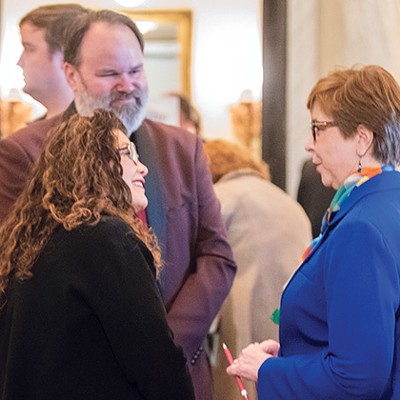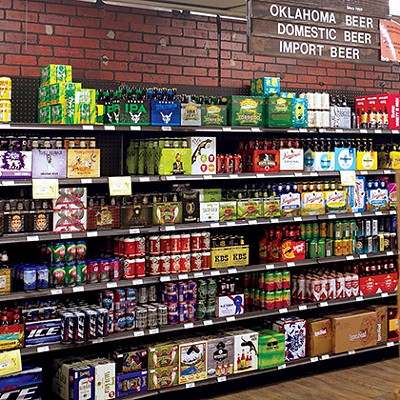If MAPS 3 wends its way through the maze of approval and retains its current form, the cracked asphalt that rambles around the Salvation Army and the empty U.S. Postal Service terminal south of Interstate 40 will be unearthed to reveal a paradise, buried for decades in a dense, urban casket.
GRAND SCHEME
FIRST CENTRAL PUBLIC SPACE
MORE WATERCOLORS THAN ACRYLICS
STATE FAIR PARK
City planners envision a verdant park stretching from the Ford Center in the northeast to Union Station in the southwest. In their minds, such a park would provide the grassy, playful glue of cohesion to bind decades of disparate development to the north with a flurry of new plots in the south.
Politically, the central park " as it's become known in the reams of planning PowerPoints associated with the Core to Shore project " may be the most palatable piece of the MAPS 3 initiative and a major selling point for city officials as they make their case to voters in the coming months.
"The leaders are very much aware that people want a park. It easy to get behind. I mean, who's against a park?" said Jeff Bezdek, the principal of Bezdek + Associates and a downtown public transit advocate.
While specific citywide interest groups have come forward with an array of proposals, discussions with those involved in the planning of Core to Shore show that the central park has developed largely in an organic manner as essential to terraforming such a massive tract of land.
GRAND SCHEME
In the grand scheme of Core to Shore, city planners have sketched out a spine of parks running south from the Ford Center on what is now Harvey Avenue, according to the 2008 rendition of the plan.
The central park would provide the headwaters and coax people farther south, where a longer promenade park would follow the Oklahoma River bank. Another park to the west would be nestled inside a residential and business district, according to plans from the developers.
In 1910, a landscape architect from Kansas City named Wilbur H. Dunn laid out a plan to build a boulevard ring around Oklahoma City. Four parks were set in the boulevard's path. That boulevard reserved the right-of-way for much of Oklahoma City's highway system and left green space that dots the metro to this day.
But one reason for the boulevard and the outskirt parks was the lack of an ability to provide a central public space, said Blair Humphreys, a graduate student in Urban Studies and Planning at the Massachusetts Institute of Technology.
Humphreys, from Oklahoma City, did his thesis research on Dunn's efforts to green the city. He said that any attempt to build a park leaves city officials dancing with old devils.
"There's certainly always been a need for park space downtown. It's something the city's struggled with since the land run, really," he said.
When the federal government divvied up the first few hundred acres of Oklahoma City in the late 1880s, it set aside no lots for public use.
FIRST CENTRAL PUBLIC SPACE
More than 40 years later, E.K. Gaylord opened the first central public space under the banner of his newspaper, The Oklahoman. The park survived only six years until The Oklahoman built a publishing plant on the space in 1929, according to Humphreys' research.
A new park would fill that need dating back to statehood, Humphreys said, but only if it is executed correctly. Several renderings and plans for the Core to Shore park float through the hands of city decision makers.
All of them include a vast, open area capable of hosting tens of thousands for an outdoor festival or performance, a lake for paddleboats and a programmable fountain. The city has contracted with the San Francisco-based Hargreaves Associates to provide a plan for the park. The design company has also worked on plans for a park on the south side of the river.
Although Humphreys and others have their own wish lists for the park, he said the most vital thing would be to tie it into a transit system capable of carrying people from other parts of downtown into the open area " another proposed feature touted as part of MAPS 3. (For more on transportation, see Page 28.)
MORE WATERCOLORS THAN ACRYLICS
Those plans, however, are more watercolors than acrylics, as a host of city groups vie for a slice of the tax that seems to be in search of a project.
Assistant City Manager Catherine O'Connor said it is still impossible to slap a price tag on projects like the park, as everything remains fluid. City officials went to Hargreaves Associates with a wish list and asked them to collect bids.
Those bids vary depending on what is included in the park plan. A proposed subterranean parking garage, for example, would significantly up the price tag, she said.
If the park is approved, it remains to be seen how it will be maintained. Options include government financing, a private foundation, like those in place at many parks around the country, or some form of a public-private partnership, O'Connor said.
Michael Laird, an original member of the Core to Shore steering committee, said all of those options had been considered as the park plans came to fruition.
"It's all about money at the end of the day," he said, "for the planning with architects and what happens after."
STATE FAIR PARK
City officials have spoken loudly and publicly about the main components for any MAPS 3 initiative. But there are a host of other pet projects floating in the crystal ball, with varying degrees of clarity.
One such project is a massive expo center on the grounds of State Fair Park, a sprawling facility geared toward trade shows and other nationally touring events.
The proposed $79 million exhibit hall would include a sky bridge linking it to other facilities, said Tim O'Toole, the state fair's general manager and president.
Oklahoma is flyover territory for many national trade shows because of its lack of a unified space with sufficient expo booths. He said that, like a convention center downtown, the exhibit hall would draw visitors to the city.
O'Toole said he has actively sought MAPS 3 funding for the center through a barrage of presentations to city leaders. If the money doesn't come, however, "We'd just have to sit and wait," he said.
Ward 8 Councilman Pat Ryan said that other proposals, such as his for a research center, have also been moved out of the limelight. In the case of the State Fair Park exhibit hall, he said, the owners have access to other funding through a hotel tax and bonds that would push it further back in the line for MAPS 3 money.
"The fairgrounds have a dedicated tax stream," Ryan said. "For something like the convention center, MAPS 3 is our only shot." "Grant Slater











